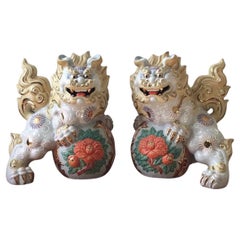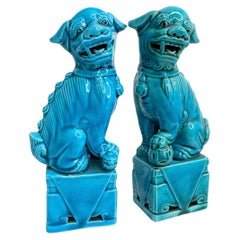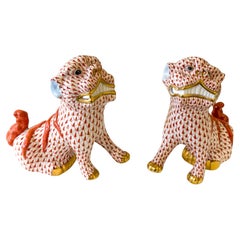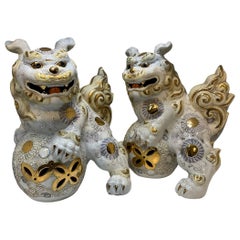Satsuma Sculptures
to
1
1
1
1
1
1
1
1
1
1
Height
to
Width
to
1
1
1
19
366
269
248
199
Creator: Satsuma
Pair of Japanese Satsuma Kutani Porcelain Foo Dogs Sculptures/Figurines
By Satsuma
Located in W Allenhurst, NJ
This is a pair of Japanese Satsuma Kutani porcelain Foo Dogs. They are hand painted white and adorned with gilt and silver suns, flowers and scrolls. Bo...
Category
1970s Japanese Chinoiserie Vintage Satsuma Sculptures
Materials
Porcelain
Related Items
Pair of Decorative Turquoise Blue Foo Dogs Sculptures, Ceramic Statue
Located in Nuernberg, DE
A very nice pair of vintage, turquoise blue, ceramic foo dogs, circa 1980s. Excellent condition and patina; makes a fun decor item in any room! Found at an estate sale in Vienna, Aus...
Category
1980s Chinese Hollywood Regency Vintage Satsuma Sculptures
Materials
Ceramic
$280 / set
H 6.25 in W 2.63 in D 1.75 in
Chinese Export Style Rust Fishnet Porcelain Herend Foo Dogs -Pair
By Herend
Located in Kennesaw, GA
This is a lovely set of Chinese Export style Herend rust fishnet foo dogs with 24K gold accents. They are marked and in very good condition. They date to t...
Category
Early 2000s Hungarian Chinese Export Satsuma Sculptures
Materials
Gold
Set of Four Porcelain White & Gold Foo Dogs
By Cerámicas BONDIA
Located in South Salem, NY
A set of four white and gold ceramic Foo Dog table bases. Made in Spain by Bondia in the Hollywood Regency style. Ornate ceramic sculptures with detailed faces, mouths, bodies, and p...
Category
Mid-20th Century Spanish Japonisme Satsuma Sculptures
Materials
Ceramic
Unique Pair of Decorative Foo Dogs Temple Lion Bookends Sculptures
Located in Nuernberg, DE
Offered is a pair of Foo Dog sculptures on a black base. These are a classic Asian decorative piece, they are made from soapstone. This type of sculpture typically depicts two guardi...
Category
1970s Chinese Vintage Satsuma Sculptures
Materials
Soapstone
$420 / set
H 7.25 in W 3.75 in D 2.38 in
Turquoise Glazed Porcelain Foo Dogs Large, a Pair
Located in Los Angeles, CA
Pair of turquoise glazed porcelain foo dogs. Large size and beautiful details. Add some classic Asian style and amazing color to your home.
Category
1950s Chinese Other Vintage Satsuma Sculptures
Materials
Porcelain
Vintage Japanese Kutani Porcelain Foo Dog Temple Lion
Located in Palm Springs, CA
Single decorative vintage Japanese Kutani porcelain ShiShi Temple Lion Foo Dog Statue. Expertly crafted and painted. Both stamped and labeled in the underside.
The Shishi, or lion-...
Category
1970s Chinese Vintage Satsuma Sculptures
Materials
Porcelain
Small Ceramic Asian Turquoise Foo Dogs, a Pair
Located in Los Angeles, CA
Fabulous pair of small Asian ceramic turquoise foo dogs with both male and female figures. The carving details are amazing. Great addition to your chinoiserie collection.
Category
1950s Chinese Chinoiserie Vintage Satsuma Sculptures
Materials
Ceramic
Vintage Chinese Porcelain Turquoise Foo Dog Figurines - a Pair
Located in Pomona, CA
This magnificent pair of Chinese Turquoise Glazed Ceramic Lion Statuary are hand made and hand carved in Museum quality. According to historical books, lions were introduced into Mai...
Category
Mid-20th Century Chinese Chinese Export Satsuma Sculptures
Materials
Porcelain
$360 Sale Price
34% Off
H 10.5 in W 4 in D 3 in
Japanese Meiji-Taisho Period Kutani Porcelain Figurine of a Rabbit, Circa 1920
Located in New York, NY
Japanese Late Meiji - Early Taisho Period Kutani Porcelain Figurine of a Rabbit, Circa 1920
MARKINGS
Signed on the underside.
DIMENSIONS
Height: 6 inches
L...
Category
1920s Japanese Japonisme Vintage Satsuma Sculptures
Materials
Porcelain
$2,800
H 6 in W 5 in D 7.5 in
Late 19th century Pair of Glazed Porcelain Foo Dogs
Located in Savannah, GA
Extraordinary pair of fine glazed porcelain Foo dogs came to us out of an estate here in Savannah, Georgia, belonging to an old general that long ago brought them from Thailand. Used...
Category
1890s Chinese Qing Antique Satsuma Sculptures
Materials
Porcelain
Pair of Chinese Porcelain Foo Dogs
Located in Pasadena, TX
Chinese Foo Dogs sculptures are often placed in pairs at the entrances of temples, palaces, and homes to serve as powerful protectors, believed to ward off evil spirits and bring pro...
Category
Late 20th Century Chinese Chinese Export Satsuma Sculptures
Materials
Porcelain
Pair of Large Chinese Turquoise Glazed Porcelain Mounted Foo Dogs
Located in Norton, MA
Fine and very detailed pair of Chinese turquoise glazed foo dogs from the mid-20th century. The hollow biscuit porcelain figures stand raised on a rectangular base and are looking si...
Category
Mid-20th Century Chinese Other Satsuma Sculptures
Materials
Porcelain
$1,675 / set
H 12.5 in W 4.5 in D 4.5 in
Previously Available Items
Pair of Japanese Satsuma Kutani Porcelain Foo Dogs Sculptures/Figurines
By Satsuma
Located in Guaynabo, PR
This is a pair of Japanese Satsuma Kutani porcelain Foo Dogs. They are hand painted white and adorned with gilt and silver suns, flowers and scrolls. Bo...
Category
20th Century Japanese Chinoiserie Satsuma Sculptures
Materials
Porcelain
Satsuma sculptures for sale on 1stDibs.
Satsuma sculptures are available for sale on 1stDibs. These distinctive items are frequently made of porcelain and are designed with extraordinary care. Prices for Satsuma sculptures can differ depending upon size, time period and other attributes — on 1stDibs, these items begin at $825 and can go as high as $825, while a piece like these, on average, fetch $825.
Questions About Satsuma Sculptures
- What is a Japanese Satsuma vase?1 Answer1stDibs ExpertOctober 12, 2021A type of Japanese pottery originated from Satsuma province in Japan is termed as Satsuma ware. A vase of this kind is known as a Satsuma vase. An interesting fact about Satsuma ware is that they feature a "makers mark" or marking as a key to help collectors unlock the value, age and authenticity of the piece. Shop a range of antique and vintage Japanese vases on 1stDibs.
- How do I date a Satsuma vase?1 Answer1stDibs ExpertMarch 22, 2022To date a Satsuma vase, study its mark. Vases made before World War II normally feature a mark in Japanese. A vase that says "Royal Satsuma" likely dates back to the late 20th century. You'll find a variety of expertly vetted Satsuma vases on 1stDibs.
- 1stDibs ExpertOctober 7, 2024The difference between Satsuma and moriage is that the former is a type of pottery, and the latter is a technique for decorating pottery. Satsuma pottery is the term for earthenware pottery from Japan's Satsuma region. Although there are different styles, the most common element of Satsuma pottery is a heavy, dark glaze. Moriage is the term for when potters add raised slip decorations to pottery, creating a three-dimensional effect. Some Satsuma pieces show off moriage details, while others do not. Shop a range of Satsuma pottery on 1stDibs.
- Is Satsuma pottery valuable?1 Answer1stDibs ExpertApril 26, 2024Yes, some Satsuma pottery is valuable. The age, type, style and condition will determine how much a particular piece is worth. In addition, the history of ownership may also make a piece more valuable. For example, if a piece was previously in the collection of a notable person, such as a member of the Japanese Imperial Family, it may be worth more. To get an estimated value for a particular piece, consult a certified appraiser or knowledgeable antiques dealer. Find a range of Satsuma pottery on 1stDibs.
- 1stDibs ExpertApril 5, 2022Satsuma porcelain or pottery includes a maker’s mark with the name of the person who made the item. Japanese numbers may also indicate that a Satsuma piece was part of a collection. Genuine Satsuma pieces will not have a “Made in Japan” label and should only include Japanese characters. When in doubt, work with a certified appraiser to determine the authenticity of your Satsuma piece. Find a variety of expertly vetted Satsuma porcelain and pottery collectibles on 1stDibs.
- 1stDibs ExpertSeptember 9, 2024Yes, some Satsuma pottery is worth something. Depending on their age, maker, type, style, condition and other factors, pieces may sell for a few hundred to several thousand dollars. Looking at sales and auction histories can give you a rough idea of the value of a piece. For a more definitive valuation, use the services of a certified appraiser or knowledgeable antique dealer. On 1stDibs, explore a collection of Satsuma pottery.
- 1stDibs ExpertFebruary 1, 2024One way to tell if your Satsuma vase is valuable is to look for markings on it. The oldest and typically most expensive pieces will usually have the Shimazu family crest — a circle with a cross through it — hand-painted on the bottom. If the piece is stamped with the marking or says "Made in Japan" in the Roman alphabet, it is a newer vase. Factors like the style of the vase and its condition will also impact its price. It's a good idea to have a certified appraiser or knowledgeable dealer evaluate your vase to determine its value. Find a variety of Satsuma vases on 1stDibs.
- 1stDibs ExpertNovember 4, 2024To identify Satsuma pottery marks, you'll typically need to perform research using trusted online resources. Satsuma is a region in Japan known for its pottery, and many factories and artisans have operated there, including Kinkozan, Taizan, Yasuda, Choshuzan, Fuzan, Gyozan, Koshida and Maruni Kobe. Each maker has its own marks associated with it, and these typically are in Japanese kanji characters. You can compare the characters on your piece to pictures shared online to find a match. Alternatively, a certified appraiser or experienced antique dealer can help you identify your pottery markings. On 1stDibs, shop a selection of Satsuma pottery.



